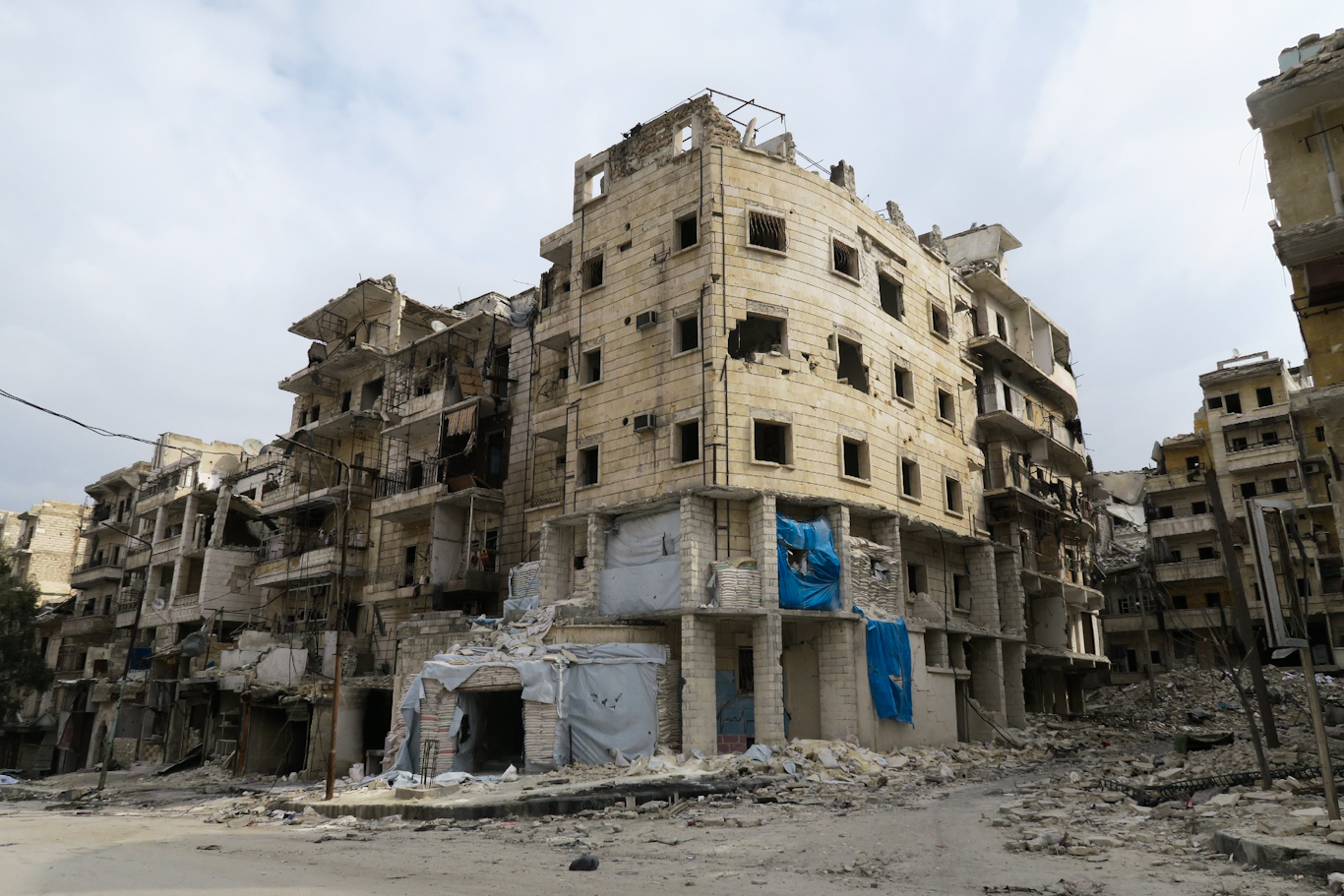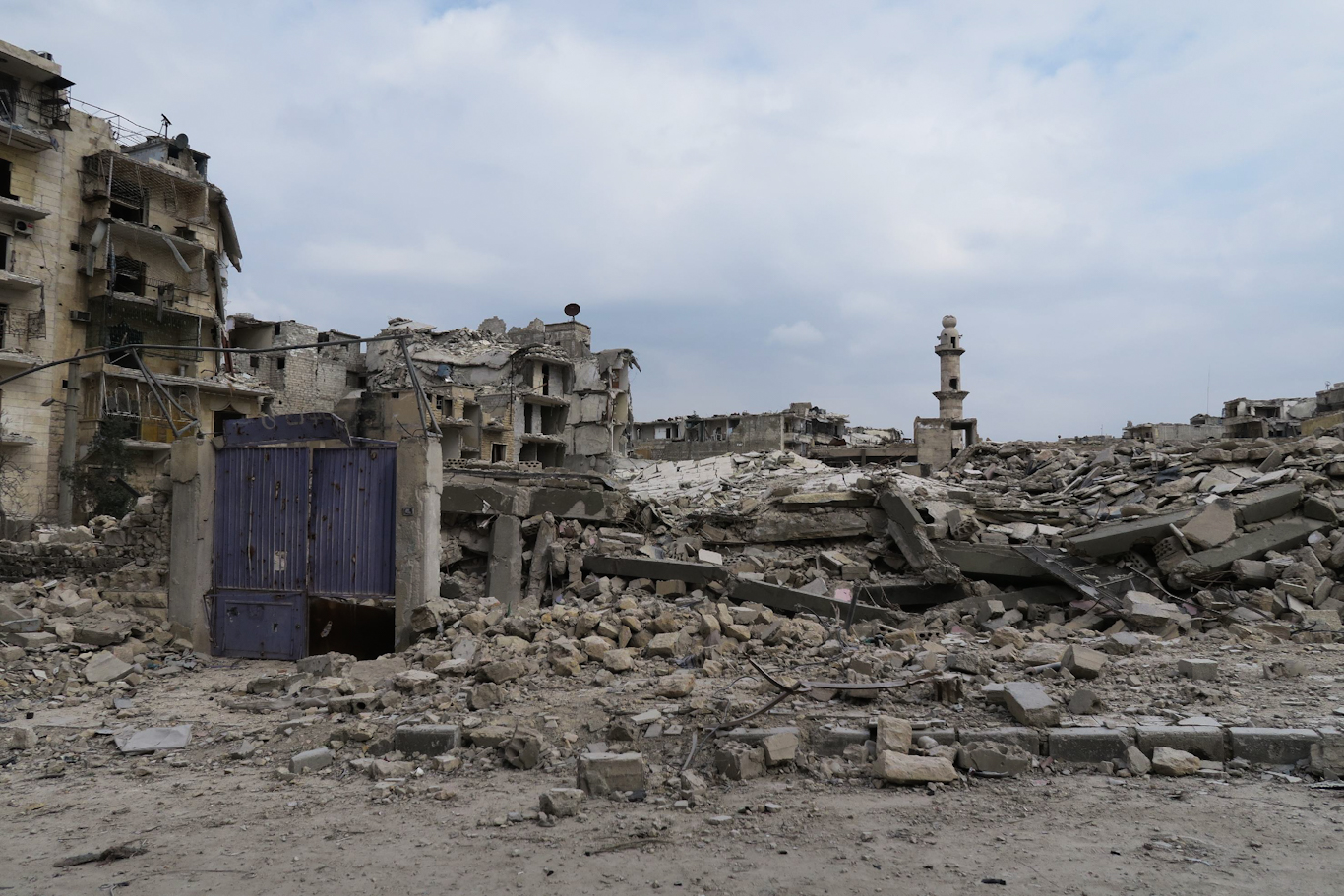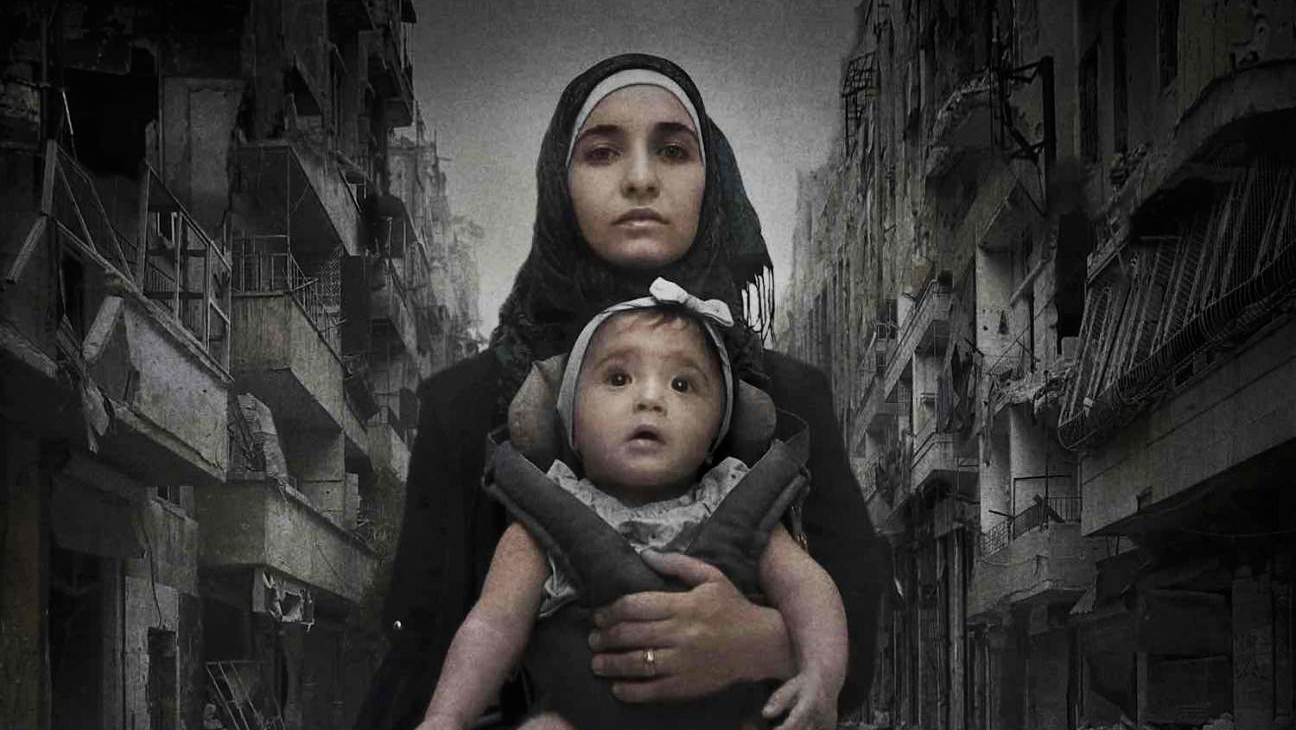he documentary movie
“For Sama” has won a host of awards in Europe and North America. Its producers and protagonists, Syrians Waad Kateab and her husband Dr. Hamza Kateab plus English film-maker Edward Watts, have received gushing praise. And the awards will probably keep coming.
Unfortunately, behind the human interest story, the film “For Sama” is little more than propaganda: biased, misleading, and politically partisan.
Hiding Basic Facts about Aleppo
“For Sama” is a full-length documentary with a moving personal story. It combines the story of young love and the birth of a child – Sama – in the midst of war. That makes it compelling and personal. But the movie fundamentally distorts reality in east Aleppo between the years 2012 and 2016. While the personal narrative may be true, the context and environment are distorted and hidden, leaving the viewer an altered idea of reality. For example:
Most East Aleppo residents did not favor militants taking over their neighborhoods. In the short video, “
Nine Days from my Window” the grim reality of a militant takeover in one East Aleppo neighborhood is shown. Many civilians fled the east side of Aleppo after the “rebels” took over. Those who stayed were mostly militants and their families, plus those who had nowhere else to go or thought they could wait it out.
The militants who took over east Aleppo became increasingly unpopular. As American journalist James Foley
wrote:
Aleppo, a city of about 3 million people, was once the financial heart of Syria. As it continues to deteriorate, many civilians here are losing patience with the increasingly violent and unrecognizable opposition — one that is hampered by infighting and a lack of structure, and deeply infiltrated by both foreign fighters and terrorist groups.”
Foley’s honest reporting may have ultimately contributed to his death.
The opposition group which ultimately came to dominate East Aleppo was al Qaeda’s Syrian offshoot, Jabhat al Nusra. “For Sama” ignores their domination, extremism and sectarian policies. There is only one fleeting reference to the group and the film fails to show exactly who was ruling East Aleppo.
In fact, the militants, a term used interchangeably with rebels, were incredibly violent and vicious. They threw
postal workers off of a building’s roof, they sent a suicide truck bomb into
Al Kindi Hospital and
slaughtered Syrian soldiers defending the hospital and they, amongst other atrocities, recorded themselves
beheading a young boy.
85 percent of the civilians in Aleppo were living in government-controlled West Aleppo. Thousands were killed by “rebel” snipers, mortars and hell cannon missiles launched from east Aleppo. The reality of life in West Aleppo, as even the BBC’s Jeremey Brown
was able to capture, is completely overlooked in “For Sama.”
Al Quds Hospital was never destroyed
The Al Quds Hospital, where “For Sama” protagonists Hamza worked and Sama was born, is featured heavily in the film. In the movie, the hospital was destroyed in February of 2016, at a time when enormous publicity swirled around allegations that Russia intentionally bombed the hospital. Doctors without Borders (Medecins sans Frontieres)
tweeted at the time that,
“We are outraged at the destruction of Al Quds hospital in #Aleppo.”

The Al Quds Hospital, the ground floor of the apartment building on the corner is shown. Photo | Nabil Antaki
After
questions were raised challenging Medecins sans Frontieres’ version of the events surrounding the destruction of Al Quds, It was revealed that the hospital did not exist before the conflict and was one or two floors of an apartment building. It turned out Doctors Without Borders did not have any staff on-site and simply parroted allegations told to them. After Wast Aleppo was liberated, Dr. Nabil Antaki, a prominent doctor from West Aleppo,
visited the location to find the truth. Antaki was a long-time doctor but had never heard of Al Quds. He reported:
I went Sunday, February 12, 2017, visiting the Ansari-Sukari neighborhood in order to see Zarzour and Al Quds Hospitals. My guide was a young man who lived there and knows very well the area.
My first stop was Zarzour hospital (mentioned in MSF report) and I found out that it was burned. My guide told me that the rebels burned it the day before the evacuation (information confirmed by a high position responsible in the Syrian Red Crescent). On the sidewalk, I found hundreds of burned new blood bags (for collection of blood donation). A man I met there invited me to visit his building just next to the hospital. His building was also burned and on the floors, I found hundreds of IV solution bags.
Then, we moved to Ain Jalout school. In fact, there are 3 contiguous schools. Two are completely destroyed; one is partially. Behind the schools, there is a mosque called Abbas mosque with its minaret. Answering my surprise to see schools destroyed by airstrikes, my guide told me that the mosque was a headquarters of the rebels and one school was an ammunition depot and the other one was a food depot. I noticed the flag of Al Nosra (sic) painted on the external wall of the school, and dozens of buildings in the surrounding partially destroyed.
Then, we moved to see Al Quds Hospital. Obviously, it is the most preserved building of the street. Obviously, it was not hit directly by bombs and probably received some fragments from bombs fallen on other buildings. I asked my guide if any restoration or repair was done. He said no.
My feeling is the following: Ain Jalout school was the target of the strikes, the surrounding destroyed buildings were collateral damages and Al Quds hospital was not directly hit by strikes.”

The bombed out Ain Jalout School, used as a Nusra ammunition and supply depot. Photo | Nabil Antaki
An eye witness account. Photographs. Video. All paint a reality starkly different from that portrayed in “For Sama.” The claims in the film about the death of a doctor at Al Quds Hospital, supposedly captured by closed caption cameras, are also untrue.
The armed opposition and their western supporters have been faking events to demonize the Syrian government from the start. Just as they did with the very public
Richard Engels Kidnapping Hoax, where militants staged the kidnapping and “rescue” of Engels and his team.
Paid and Promoted by the West
Waad Kateab, the film’s main protagonist, had an expensive video camera and endless hard drives. She even had a drone to take video from the air. As confirmed by Hillary Clinton in her book “Hard Choices,” the U.S. provided “satellite-linked computers, telephones, cameras, and training for more than a thousand activists, students, and independent journalists.”
Waad claims she is a citizen journalist but has been paid and supplied by governments that have long sought the overthrow of the Syrian government. Even in 2005, CNN host Christiane Amanpour
warned Bashar al Assad that “the rhetoric of regime change is headed towards you from the United States. They are actively looking for a new Syrian leader … They’re talking about isolating you diplomatically and, perhaps, a coup d’etat or your regime crumbling.”
Since 2011, the West, Turkey, Israel, and the Gulf monarchies have spent many billions trying to overthrow the Syrian government. The
CIA budget for Syria was near a billion per year. These “soft power” components include video equipment and training for people like Waad to support the armed insurrection, demonize the Syrian government and persuade the public to continue the war.
We all suffered… The difference is that some wanted the war.”
The medical doctor from west Aleppo, Dr. Antaki, does not deny there was suffering in east Aleppo. But he points out the discrepancy in media coverage where all the attention goes to the “rebels.” He also points out that all suffered, but not all were responsible. Some, especially supporters of the “revolution,” initiated and continued the conflict. Dr. Antaki said on the subject:
There were a lot of stories like ‘For Sama’ in West Aleppo. Unfortunately, nobody had the idea to document them because we were busy trying to protect ourselves from the rockets, to find water to drink, to find bread and essential products which were not available because of the blockade of Aleppo by the armed groups. They cut off electrical power, heating etc.. Yes, people who were in the East neighborhoods suffered from the war as well as those who lived in the West neighborhoods. We, all, suffered. The difference is that some people wanted the war, initiated or supported it and they suffer. The others didn’t support it and suffered.”
The Aftermath
Waad Al Kateab and her husband Hamza are now living in the UK. He is working for a money transfer company and involved with the “Al Quds Hospital” in Idlib. As indicated in the movie, Waad was never proud to be Syrian and she wanted to emigrate to the West. From afar, she claims to be proud of the “revolution” that has led to the destruction of Syria and the human tragedy that accompanied it.
Meanwhile, people are returning to Aleppo and rebuilding the city. There are even a few
tourists. Although
pockets of snipers still exist in Aleppo, the al Qaeda extremism which once plagued the city is now mostly confined to Idlib.
Save Idlib?
The 2019 documentary “Of Fathers and Sons” is based on a film-maker who lived with militants in Idlib. Some of the reality hidden from the audience in “For Sama” is revealed in this documentary. “Of Fathers and Sons” shows life in Idlib province dominated by Nusra. Women are restricted to the house and must be veiled. Boys as young as ten are sent to sharia school and military training preparing them to join Nusra. They believe in the Taliban, glorify 9-11 and expel or punish anyone who does not subscribe to their fundamentalism. Youth are indoctrinated with extremist ideology and a belief in violence. This is the regime that those who want to “Save Idlib” are protecting.
The Future
Unbeknownst in the West, the majority of Syrians support their government, admire their president, and feel that the Syrian Army is protecting them. Even those who are critical of the government prefer it to chaos or Salafi fundamentalism. Waad and Hamza Al Kateab represent a tiny minority of Syrians. Their voices and the perspective of Edward Watts, the filmmaker (who has never been to Syria) are being widely projected and disseminated through “For Sama.” Other voices are being ignored.
When Waad and Hamza departed Aleppo with Nusra militants, the vast majority of Aleppans
celebrated. On the surface, “For Sama” is about romance and childbirth. Underneath it is very political, as
interviews with the producers confirmed. For this, it will likely be widely promoted precisely because it gives a distorted picture. To continue the
dirty war on Syria, public misunderstanding is required.
Feature photo | A screenshot from a trailer for the documentary film, “For Sana.”
Rick Sterling is an investigative journalist based in the SF Bay Area of California. He can be reached at rsterling1@gmail.com
The views expressed in this article are the author’s own and do not necessarily reflect MintPress News editorial policy.



 Uprooted Palestinian
Uprooted Palestinian 











No comments:
Post a Comment